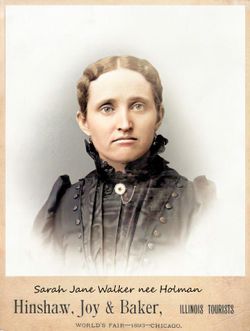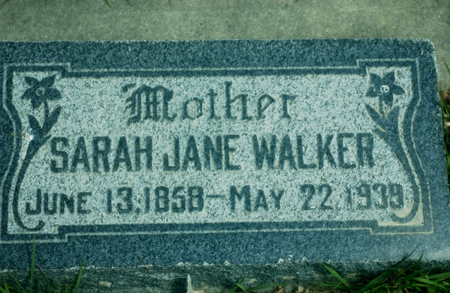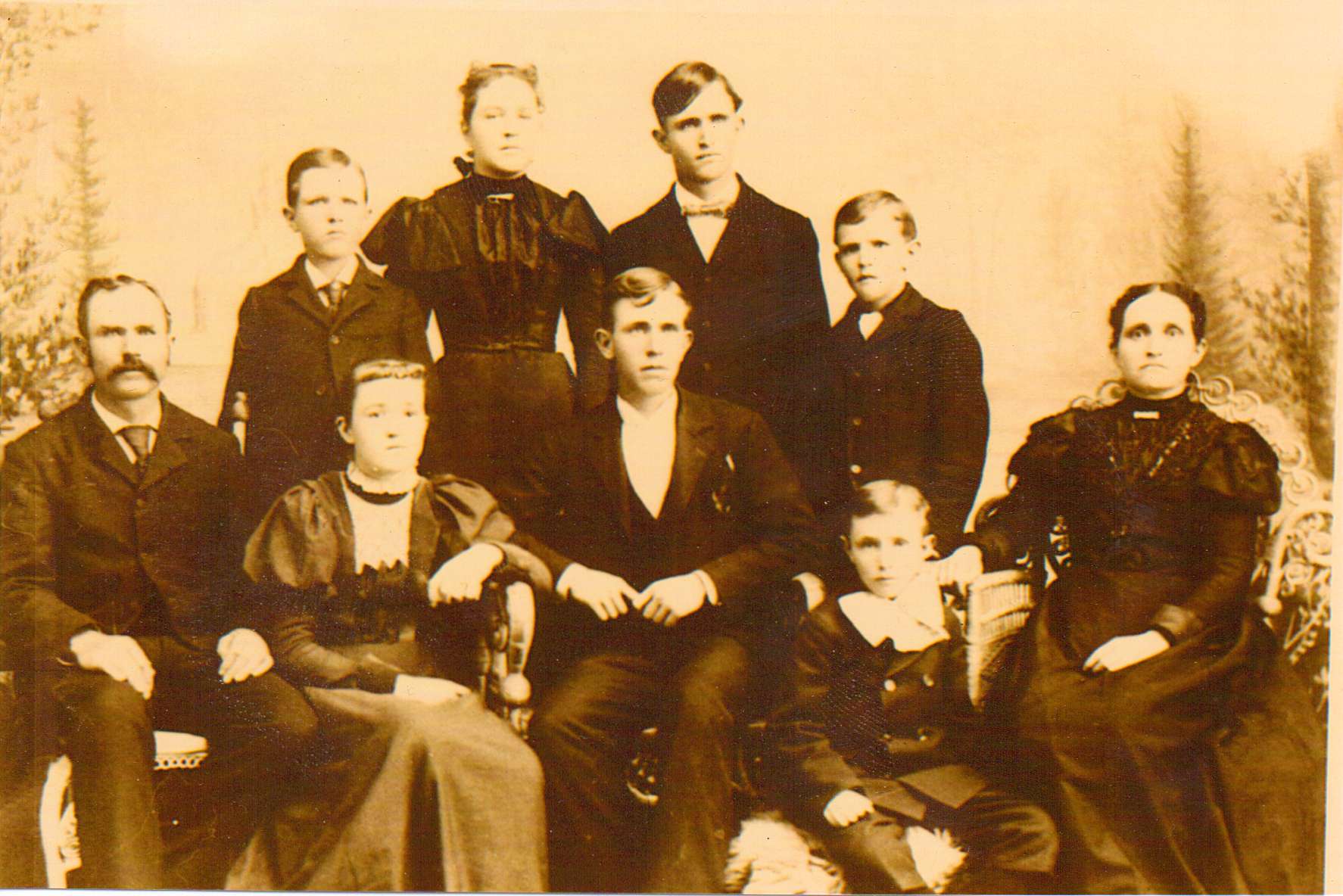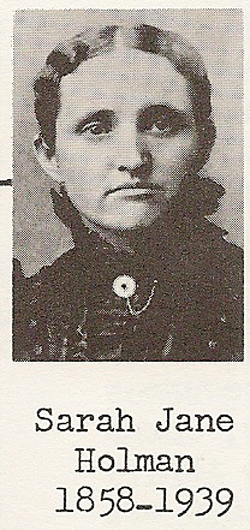Sara Jane was the second child of 13 born to her parents in Santaquin, Utah. The morning she was born the townspeople were assembled in church to be organized into a ward and sustain their first bishop. So interested were the townspeople in this event that the young father had difficulty finding anyone to care for the new baby when she arrived. It so happened that Sara Jane's grandfather was called to be the new bishop. He blessed her, naming her in honor of her mother and her mother's younger sister. She was affectionately nicknamed "Little Sis". At the age of 4, Sara Jane and family moved to Fountain Green, Sanpete County where her father ran a mercantile. She would sometimes visit extended family back in Santaquin and Payson but usually got so homesick before she could get back that the trip was nearly spoiled. At age 6 she started school. The indians began to be troublesome, often driving away the horses and cattle. Each week they became more daring. One day the indians came suddenly upon the men herding cattle, killing some of the men, wounding others and driving away all the animals they could. That spring her father broke his arm near the shoulder. The bone refused to knit. The nearest doctor lived in Provo, and trips could not be made often. He was kept in bed most of the summer in an almost helpless condition. Little Sis was old enough to realize how helpless they would be if the indians should come upon them. That spring the indians were really on the warpath. The people were advised to move to larger settlements where they could protect themselves. One May afternoon, her little sister Zilpha disappeared. After much hunting and inquiring she was found under her mothers' bed where she had crawled and gone to sleep. She complained of a pain in her head. She grew rapidly worse and for 8 days the struggle between life and death went on until she died. The little body was prepared for burial, their household effects were loaded into the wagons and with heavy hearts they started for the north. They brought what they could of their cattle and their belongings to Santaquin. Here little Zilpha was laid to rest at the town cemetary. The family remained in Santaquin a few weeks and then went on to Pleasant Grove. Here Little Sis spent her 8th birthday. Now her father told her she must be rid of this nickname. Until now, she hardly knew she had any other name. They purchased the property where Alice Robbins now lives and moved into the frame house that stood on the southeast corner of the lot. In September 1866, she was baptized in Utah Lake by Henson Walker. This was the first time she had seen the lake. Great fear seized the little girl at the sight of so much water and she wished she were at home with her mother. She had been placed in the charge of Sister Mary Armistead who tried to comfort and reassure her but insisted that the ordinance be performed.
Sara Jane read everything she could find to read. She was apt in spelling.
In the fall of 1866, the family again passed through sorrow as Frankie (age 2 1/2 years) died of croup. Father was away from home at the time and mother had a young baby only a few months old. There were few conveniences and Sara Jane had many duties and was only able to attend school a few weeks in the winter. After the railroad was finished, her father contracted to haul wood from American Fork canyon. Jane went with him to cook for the men. She was 16 years old now and quite grown up. Across the street lived the Walker family and a boy by the name of Appollos Benjamin who showed a fondness for her. She often went horseback riding, wagon riding, to dances, candy pulls, and peach cuttings with the boys in town but none seemed to suit her like A.B. He had worked on his father's farm and now went into the canyon to work at community flat and spent the summer at Deer Creek cooking for the men who worked there. In October 1874, these young people, with several other young couples, were called to the endowment house to receive their endowment. Sara Jane continue work in American Fork Canyon from season to seaon and subsequently went to Butterfield to help cook for the men who hauled ore and she was able to come home once a month. Later, she worked for Henry Simpson, the village blacksmith. Her experiences were many and varied. She learned to cook well, sew, make soap, dye cloth, in fact everything that came in the managment of a home. The madder root furnished a brilliant red, the yellows were made from copperous, the green from peach leaves and the blue from indigo root dissoved in lye. During this time, her father kept the feed yards in town. Here also the horses were kept for the Pony Express. Her father carrying mail from Pleasant Grove to Manti. Later a stagecoach with four horses took the place of the Pony Express. This coach met the train at Lehi which carried passengers and mail as far south as San Francisco.
She had been keeping company with A.B. for two years. During the winter of 1875-76 her father lost his home. He had borrowed money to go into the saloon business. This venture proved a failure. His family consisted mostly of boys and he had no land in Pleasant Grove so he decided to go back to Fountain Green where there was plenty of land to furnish work for his boys. A.B. realized that this move would be a serious handicap to courting. He was a firm believer in the scriptures, and had for nearly two years, loved his neighbor's daughter as himself. Arrangements were made and on the 24 April 1876, this happy couple went back to the endowment house and were sealed and settled down to a new life together. They occupied the home left by her father. Their furniture consisted of a stove, a bedstead, 6 chairs, a clock and a mirror. They bought 10$ worth of dishes, utensils and kitchen equipment. This seemed extravagent for those times. Their first baby was born March 17, 1877. By August 1880 they had two sons and one daughter. Spring of 1881 they moved to Lindon, Utah where they were blessed with four more children. She was called as a Relief Society teacher. She made her rounds on foot many miles along the canyon road and through the tall sage brush.
In September 1888, daughter Jennie came down with typhoid fever. The child grew steadily worse and was delirius for many days. Those who waited upon her knew that only the power of God could save her. Their fasting, faith and prayers brought divine help and she began to mend. What a relief to anxious parents when at least they could see gradual improvement.
In October 1891, A.B. left for the Central States mission. Jane had not been well but had tried to help him get ready to go. The day after he left, she went to bed to stay for some time as she was down with a fever. For some time it was feared that the missionary would have to return, but providence and kind friends came to the rescue.
When the Lindon ward was organized, she was a member of the old folks committee and trustee of the Relief Society. She was in charge of the Relief Society granary. The wheat had to be changed every year to prevent weavil from getting into it. A market must be found and new wheat put in its place. She held this position until the general authorities advised the storing of all Relief Society wheat in elevators. She was called as a Sunday School teacher in 1892 and served for many years. While A.B. was on his mission, she was able to provide for the family, keep A.B. in the mission field, and begin to buy a piece of property they had long wanted to own. In the fall of 1897 she became ill with typhoid fever and pneumonia. Her life hung in the balance for many days. A ward fast was held on her behalf and she improved slowly. When Christmas time came, she was able to be up and about but was thin and pale and lost nearly all her hair. A.B. returned from his mission in April 1900.. what a time of rejoicing! Sons, James H, and Ben had married, Lawrence, Jessie and Robert began work at the University of Utah. Margaret went along to keep house for them. Jennie had also started teaching school. Now A.B. and Sara Jane could begin to think of the future and their own comfort and pleasure and they laid many plans. Christmas in 1909, the family all gathered for celebration. Father, mother, all the children and grandchildren, 31 all together. A few days later A. B. contracted a severe cold and his health failed rapidly until his death February 3, 1910. The light seemed to fade out of Sara Janes' life and she could not be comforted. The once sunny, hopeful disposition, so characteristic of her life became melancholy and almost morose. She became pale and thin and sobbed in her sleep. Her parents gave up their home and came to live with her to try and console her. The previous winter her brother in law, Chris Iverson, became very ill and on his deathbed asked Sara Jane to care for his 12 year old daughter Evelyn. This she did, being a real mother to her, giving her the same opportunities she had given her own. Her parents remained with her until their deaths. She was always patient and considerate of them. In 1918, the dream of making a trip East was finally realized. James H. and his wife took her with them to attend the National Education Association convention in Philadelphia. They visited many places of interest and came home through Michigan where they spent a week with relatives of the Walker family. In 1937, her son James H. passed away. This was a great shock to her, then as she began to rally, her son Robert died five months later. This was too much for her. In May 1939, she visited her daughter Margaret West. While there she fell breaking her hip. She died May 22, 1939 after several weeks of suffering. She always tried to tend to her church duties, paid her tithing by the month. She made her last tithing payment just a few days before she died although she was suffering intensely, she still thought of that and wanted it done. Her funeral was held in the stake tabernacle May 25, 1939.
Sara Jane was the second child of 13 born to her parents in Santaquin, Utah. The morning she was born the townspeople were assembled in church to be organized into a ward and sustain their first bishop. So interested were the townspeople in this event that the young father had difficulty finding anyone to care for the new baby when she arrived. It so happened that Sara Jane's grandfather was called to be the new bishop. He blessed her, naming her in honor of her mother and her mother's younger sister. She was affectionately nicknamed "Little Sis". At the age of 4, Sara Jane and family moved to Fountain Green, Sanpete County where her father ran a mercantile. She would sometimes visit extended family back in Santaquin and Payson but usually got so homesick before she could get back that the trip was nearly spoiled. At age 6 she started school. The indians began to be troublesome, often driving away the horses and cattle. Each week they became more daring. One day the indians came suddenly upon the men herding cattle, killing some of the men, wounding others and driving away all the animals they could. That spring her father broke his arm near the shoulder. The bone refused to knit. The nearest doctor lived in Provo, and trips could not be made often. He was kept in bed most of the summer in an almost helpless condition. Little Sis was old enough to realize how helpless they would be if the indians should come upon them. That spring the indians were really on the warpath. The people were advised to move to larger settlements where they could protect themselves. One May afternoon, her little sister Zilpha disappeared. After much hunting and inquiring she was found under her mothers' bed where she had crawled and gone to sleep. She complained of a pain in her head. She grew rapidly worse and for 8 days the struggle between life and death went on until she died. The little body was prepared for burial, their household effects were loaded into the wagons and with heavy hearts they started for the north. They brought what they could of their cattle and their belongings to Santaquin. Here little Zilpha was laid to rest at the town cemetary. The family remained in Santaquin a few weeks and then went on to Pleasant Grove. Here Little Sis spent her 8th birthday. Now her father told her she must be rid of this nickname. Until now, she hardly knew she had any other name. They purchased the property where Alice Robbins now lives and moved into the frame house that stood on the southeast corner of the lot. In September 1866, she was baptized in Utah Lake by Henson Walker. This was the first time she had seen the lake. Great fear seized the little girl at the sight of so much water and she wished she were at home with her mother. She had been placed in the charge of Sister Mary Armistead who tried to comfort and reassure her but insisted that the ordinance be performed.
Sara Jane read everything she could find to read. She was apt in spelling.
In the fall of 1866, the family again passed through sorrow as Frankie (age 2 1/2 years) died of croup. Father was away from home at the time and mother had a young baby only a few months old. There were few conveniences and Sara Jane had many duties and was only able to attend school a few weeks in the winter. After the railroad was finished, her father contracted to haul wood from American Fork canyon. Jane went with him to cook for the men. She was 16 years old now and quite grown up. Across the street lived the Walker family and a boy by the name of Appollos Benjamin who showed a fondness for her. She often went horseback riding, wagon riding, to dances, candy pulls, and peach cuttings with the boys in town but none seemed to suit her like A.B. He had worked on his father's farm and now went into the canyon to work at community flat and spent the summer at Deer Creek cooking for the men who worked there. In October 1874, these young people, with several other young couples, were called to the endowment house to receive their endowment. Sara Jane continue work in American Fork Canyon from season to seaon and subsequently went to Butterfield to help cook for the men who hauled ore and she was able to come home once a month. Later, she worked for Henry Simpson, the village blacksmith. Her experiences were many and varied. She learned to cook well, sew, make soap, dye cloth, in fact everything that came in the managment of a home. The madder root furnished a brilliant red, the yellows were made from copperous, the green from peach leaves and the blue from indigo root dissoved in lye. During this time, her father kept the feed yards in town. Here also the horses were kept for the Pony Express. Her father carrying mail from Pleasant Grove to Manti. Later a stagecoach with four horses took the place of the Pony Express. This coach met the train at Lehi which carried passengers and mail as far south as San Francisco.
She had been keeping company with A.B. for two years. During the winter of 1875-76 her father lost his home. He had borrowed money to go into the saloon business. This venture proved a failure. His family consisted mostly of boys and he had no land in Pleasant Grove so he decided to go back to Fountain Green where there was plenty of land to furnish work for his boys. A.B. realized that this move would be a serious handicap to courting. He was a firm believer in the scriptures, and had for nearly two years, loved his neighbor's daughter as himself. Arrangements were made and on the 24 April 1876, this happy couple went back to the endowment house and were sealed and settled down to a new life together. They occupied the home left by her father. Their furniture consisted of a stove, a bedstead, 6 chairs, a clock and a mirror. They bought 10$ worth of dishes, utensils and kitchen equipment. This seemed extravagent for those times. Their first baby was born March 17, 1877. By August 1880 they had two sons and one daughter. Spring of 1881 they moved to Lindon, Utah where they were blessed with four more children. She was called as a Relief Society teacher. She made her rounds on foot many miles along the canyon road and through the tall sage brush.
In September 1888, daughter Jennie came down with typhoid fever. The child grew steadily worse and was delirius for many days. Those who waited upon her knew that only the power of God could save her. Their fasting, faith and prayers brought divine help and she began to mend. What a relief to anxious parents when at least they could see gradual improvement.
In October 1891, A.B. left for the Central States mission. Jane had not been well but had tried to help him get ready to go. The day after he left, she went to bed to stay for some time as she was down with a fever. For some time it was feared that the missionary would have to return, but providence and kind friends came to the rescue.
When the Lindon ward was organized, she was a member of the old folks committee and trustee of the Relief Society. She was in charge of the Relief Society granary. The wheat had to be changed every year to prevent weavil from getting into it. A market must be found and new wheat put in its place. She held this position until the general authorities advised the storing of all Relief Society wheat in elevators. She was called as a Sunday School teacher in 1892 and served for many years. While A.B. was on his mission, she was able to provide for the family, keep A.B. in the mission field, and begin to buy a piece of property they had long wanted to own. In the fall of 1897 she became ill with typhoid fever and pneumonia. Her life hung in the balance for many days. A ward fast was held on her behalf and she improved slowly. When Christmas time came, she was able to be up and about but was thin and pale and lost nearly all her hair. A.B. returned from his mission in April 1900.. what a time of rejoicing! Sons, James H, and Ben had married, Lawrence, Jessie and Robert began work at the University of Utah. Margaret went along to keep house for them. Jennie had also started teaching school. Now A.B. and Sara Jane could begin to think of the future and their own comfort and pleasure and they laid many plans. Christmas in 1909, the family all gathered for celebration. Father, mother, all the children and grandchildren, 31 all together. A few days later A. B. contracted a severe cold and his health failed rapidly until his death February 3, 1910. The light seemed to fade out of Sara Janes' life and she could not be comforted. The once sunny, hopeful disposition, so characteristic of her life became melancholy and almost morose. She became pale and thin and sobbed in her sleep. Her parents gave up their home and came to live with her to try and console her. The previous winter her brother in law, Chris Iverson, became very ill and on his deathbed asked Sara Jane to care for his 12 year old daughter Evelyn. This she did, being a real mother to her, giving her the same opportunities she had given her own. Her parents remained with her until their deaths. She was always patient and considerate of them. In 1918, the dream of making a trip East was finally realized. James H. and his wife took her with them to attend the National Education Association convention in Philadelphia. They visited many places of interest and came home through Michigan where they spent a week with relatives of the Walker family. In 1937, her son James H. passed away. This was a great shock to her, then as she began to rally, her son Robert died five months later. This was too much for her. In May 1939, she visited her daughter Margaret West. While there she fell breaking her hip. She died May 22, 1939 after several weeks of suffering. She always tried to tend to her church duties, paid her tithing by the month. She made her last tithing payment just a few days before she died although she was suffering intensely, she still thought of that and wanted it done. Her funeral was held in the stake tabernacle May 25, 1939.
Family Members
-
![]()
James Isaac Holman
1856–1940
-
![]()
John Alonzo Holman
1859–1935
-
![]()
David William Holman
1861–1929
-
Zilphia Ann Holman
1862–1866
-
Willard Franklin Holman
1865–1867
-
![]()
Nancy Melissa Holman Low
1866–1951
-
![]()
Parley Thomas Holman
1868–1944
-
![]()
Warren Mathis Holman
1871–1940
-
![]()
Martin Elmer Holman
1873–1896
-
![]()
Naomi Elizabeth Holman Huggins
1875–1940
-
![]()
Robert Ross Holman
1877–1950
-
![]()
Ezra Ray Holman
1879–1967
Sponsored by Ancestry
Advertisement
Advertisement



























